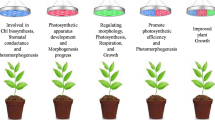Summary
Photosynthetic capacities and respiration rates of Alocasia macrorrhiza leaves were measured for 4 weeks following reciprocal transfers between high (20% of full sun) and low (1% of full sun) light environments. Photosynthetic capacities and respiration rates of mature, high-light leaves were 1.7 and 4.5 times those of low-light leaves, respectively. Following transfer, respiration rates adjusted within 1 week to those characteristic of plants grown in the new environment. By contrast, photosynthetic capacities either did not adjust or changed only slowly following transfer. Most of the difference in respiration between high- and low-light leaves was related to the carbohydrate status as determined by the daily PFD and little was directly related to the maintenance costs of the photosynthetic apparatus. Leaf construction cost was directly proportional to maximum photosynthetic capacity. Consequently, although daily carbon gain per unit leaf area was the same for low-light and high to low-light transferred plants within a week after transfer, the carbon return per unit of carbon investment in the leaves remained lower in the high to low transfer plants throughout the 4 week measurement period. Conversely, in high-light, the low leaf construction cost of the low to high-light transferred plants resulted in carbon gain per unit investment just as high as that of the high-light plants.
Similar content being viewed by others
References
Aslam M, Huffaker RC (1982) In vivo nitrate reduction in roots and shoots of barley (Hordeum vulgare L.) seedlings in light and darkness. Plant Physiol 70:1009–1013
Azcon-Bieto L, Lambers H, Day DA (1983) Effect of photosynthesis and carbohydrate status on respiratory rates and the involvement of the alternative pathway in leaf respiration. Plant Physiol 72:598–603
Azcon-Bieto J, Osmond CB (1983) Relationship between photosynthesis and respiration: The effect of carbohydrate status on the rate of CO2 production by respiration in darkened and illuminated wheat leaves. Plant Physiol 71:574–581
Besford RT (1986) Changes in some calvin cycle enzymes of the tomato during acclimation to irradiance. J Exp Bot 37:200–210
Bjorkman O (1972) Photosynthetic adaptation to contrasting light climates. Carnegie Inst Yearbook 71:82–107
Bjorkman O (1981) Responses to different quantum flux densities. In: Lange OL, Nobel PS, Osmond CB, Ziegler H (eds) Physiol Plant Ecology I. (Encyclopedia of plant physiology, NS vol 12A). Springer, Berlin Heidelberg New York, pp 57–107
Blenkinsop PG, Dale JE (1974) The effects of shade treatment and light intensity on ribulose-1,5-diphosphate carboxylase activity and fraction I protein level in the first leaf of barley. J Exp Bot 25:899–912
Boardman NK (1977) Comparative photosynthesis of sun and shade plants. Annu Rev Plant Physiol 28:355–377
Caemmerer S von, Farquhar GD (1981) Some relationships between the biochemistry of photosynthesis and the gas exchange of leaves. Planta 153:376–387
Givnish TJ (1988) Adaptation to sun and shade: A whole-plant perspective. Aust J Plant Physiol 15:63–92
Heichel GH (1970) Prior illumination and the respiration of maize leaves in the dark. Plant Physiol 46:359–362
Ho LC, Thornley JHM (1978) Energy requirements for assimilate translocation from mature tomato leaves. Ann Bot 42:481–483
Irving DE, Silsbury JH (1988) The respiration of mature field been (Vicia faba L.) leaves during prolonged darkness. Ann Bot 62:473–479
Jurik TW, Chabot BF (1986) Leaf dynamics and profitability in wild strawberries. Oecologia 69:296–304
Lambers H (1985) Respiration in intact plants and tissues: Its regulation and dependence on environmental factors, metabolism and invaded organisms. In: Douce D and Day DA (eds) Higher Plant Cell Respiration. (Encyclopedia of Plant Physiology, NS vol 18). Springer, Berlin Heidelberg New York, pp 418–473
Laties GG (1982) The cyanide-resistant, alternative path in higher plant respiration. Ann Rew Plant Physiol 33:519–55
Ludwig LJ, Charles-Edwards DA, Withers AC (1975) Tomato leaf photosynthesis and respiration in various light and carbon dioxide environments. Environmental and Biological Control of Photosynthesis In: Marcelle R, Junk W, (eds), The Hague pp. 29–36
Oji Y, Otani Y, Hosomi Y, Wakiuchi N, Shiga H (1989) Nitrate reduction in root and shoot and exchange of reduced nitrogen between organs in two-row barley seedlings under light-dark cycles. Planta 79:359–366
Powles SB, Critchley C (1980) Effect of light intensity during growth on photoinhibition of intact attached bean leaflets. Plant Physiol 65:1181–1187
Raven JA (1989) Fight or flight: the economics of repair and avoidance of photoinhibition. Funct Ecol 3:5–19
Rice SA, Bazzaz FA (1989) Growth consequences of plasticity of plant traits in response to light conditions. Oecologia 78:508–512
Sebaa EL, Prioul D, Brangeon JL (1987) Acclimation of adult Lolium multiflorum leaves to changes in irradiance: effect on leaf photosynthesis and chloroplast ultrastructure. J Plant Physiol 127:431–441
Sims DA, Pearcy RW (1989) Photosynthetic characteristics of a understory herb, Alocasia macrorrhiza, and a related crop species, Colocasia esculenta grown in contrasting light environments. Oecologia 79:53–59
Williams K, Field CB, Mooney HA (1989) Relationships among leaf construction cost, leaf longevity, and light environment in rain-forest plants of the genus Piper. Am Nat 133:198–211
Williams K, Percival F, Merino J, Mooney HA (1987) Estimation of tissue construction cost from heat of combustion and organic nitrogen content. Plant Cell Envir 10:725–734
Author information
Authors and Affiliations
Rights and permissions
About this article
Cite this article
Sims, D.A., Pearcy, R.W. Photosynthesis and respiration in Alocasia macrorrhiza following transfers to high and low light. Oecologia 86, 447–453 (1991). https://doi.org/10.1007/BF00317615
Received:
Accepted:
Issue Date:
DOI: https://doi.org/10.1007/BF00317615




